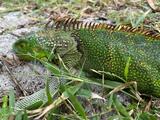Burmese python invasion spreading in Florida and no solution in sight, study warns
MIAMI — When Leonardo Sanchez began walking the levees in south Florida as a wildlife volunteer in 2011 he realized there was a serious problem. They were finding large 14-feet Burmese pythons on a daily basis.
But it wasn’t until three years later that the state decided to put a bounty on their heads and initiated a python eradication campaign.
It was too late.
Sanchez was one of the first group of eight hunters who were given a key to the protected levees by the state and handed out contracts to volunteer python hunters.
““We are fighting hard and we are doing a good job. But we’re definitely not winning. They are going to be here forever,” said Sanchez, who explained that by the time the state responded the python population had exploded.
A new scientific review by the U.S. Geological Survey found that the giant snakes, than can grow to 20-feet long and over 200 pounds in weight, are continuing to spread out in all directions from their breeding ground in the Everglades reaching the urban areas of greater Miami, Palm Beach and Fort Myers and even threatening as far north as Lake Okeechobee just south of Orlando.
The study called the state’s python problem “one of the most intractable invasive-species management issues across the globe,” adding that the python population is unknown, but feared to be growing rapidly.
Despite the ramped up effort to control the proliferating python population, including sniffer dogs and an annual hunt with a $10,000 grand prize for the largest snake, it’s all beginning to look like a losing battle.
The study recommended greater investment in research to find new ways to track and eradicate pythons, adding that controlling the python invasion was critical to critical to protecting the Everglades National Park, which covers 1.5 million acres of tropical and subtropical habitat with one of the world’s most diverse ecosystems.
The giant, non-venomous, constrictors were introduced to South Florida in the early 1990s after Hurricane Andrew destroyed a reptile business that was breeding pythons as pets. Thousands are believed to have escaped into the wild.
“We were the epicenter” said Manuel Hernandez, a local reptile trapper, describing where the pythons first escaped in 1992 in an area south of Miami called The Redland, about 30 miles south of Miami. “From here they spread out south and west and slowly up the south-eastern seaboard towards Miami.”
They took advantage of the expansive network of drainage canals in the area. “The snakes cross through corridors, they are great swimmers,” he added.
The python war
In recent years more than 11,250 pythons have been hand captured and removed by licensed state hunters, said McKayla Spencer, the Nonnative Fish and Wildlife Program Coordinator at the Florida Fish & Wildlife Conservation Commission (FWC).
Several thousand more have been killed by members of the public who are being encouraged by the state to hunt the pythons down, without need of a permit. “We encourage members of the public to remove and humanely kill pythons whenever possible on private lands with landowner permission,” said Spencer. “Every python removed is one less python making a negative impact on the Everglades ecosystem,” she added.
There are now more than 100 python contractors working for the FWC Python Action Team and a separate Python Elimination Program run by the South Florida Water Management District.
“I’m a reptile lover. I do it for fun,” said Sanchez, a 51-year-old Nicaraguan-born immigrant who keeps 16 snakes at home but recognizes that the wild pythons are destroying the native species.
If the weather is good, he goes out at night once or twice a week to hunt pythons after he finishes his day job erecting electric power poles. “It’s my happy place. It’s where I was off my stress from a day of work,” is how he describes his nocturnal hunting for snakes.
Sometimes his daughter joins him, or he teams up with other contractors. His prize catch so far was a 15 foot, 2 inch female, weighing 144 pounds and carrying more than 80 eggs. He estimates he’s caught a total of 150-200 snakes over the last 12 years.
“I do it barehanded. I like the fight they put up,” he said.
Giant pythons have turned the The Everlades into a private "buffet"
The Everglades also provide an ample diet for the pythons, including wading birds, rabbits and deer. The USGS review found the remains of 76 prey species in python digestive tracts, which primarily included mammals and birds, as well as two reptile species, the American alligator and green iguana.
When one team of researchers put GPS collars on local possums in order to track them, they were mystified when the subjects they were studying began to disappear. Then one of the collars showed up in an X-ray of a pythons’ stomach.
A team of biologists last year captured the largest Burmese python ever captured in Florida. The female python weighed in at 215 pounds (98 kilograms), was nearly 18 feet long (5 meters) and had 122 eggs, the Conservancy of Southwest Florida said in a news release.
The team were led to the female using radio transmitters transplanted in male snakes to study python movements, breeding behaviors and habitat use.
A necropsy also found hoof cores in the snake’s digest system, meaning that an adult white-tailed deer was its last meal.
Pythons are hard to detect and capture
One of the biggest issues is controlling the Burmese python invasion has been the difficulty of visually detecting them due to their brown and beige skin," according to the lead author of the USGS study, Jacquelyn Guzy. Nor is it easy trapping them in the vast, inaccessible wilderness of the Everglades. “Pythons do not readily enter any type of trap, occupy vast stretches of inaccessible habitat, and camouflage extremely well within the subtropical Florida environment,” she wrote.
In addition to smell and sight, pythons have an additional sense, endowed with tiny heat-sensitive organs that they use for hunting, located along their lips.
Although the contractors have been effective in some areas, there were vast patches deep inside the Everglades where the trappers have not ventured. The contract killers are also only allowed up to 15 miles inside the park gates protecting the levees. “There must be thousands of larger, smarter pythons deep in there,” said Sanchez.
In one area he and some of his colleagues captured several large snakes a few years ago near a levee in an area known as the Big Cypress Swamp. “There wasn’t a bird in sight when we got there,” said Sanchez. “They (the pythons) were having a buffet there,” he added. Now, the birds have returned and even a family of wild pigs.
Experts say the pythons thrive in South Florida’s large network of canals and levees, able to travel more than a mile in a single day.
“They like to stay close to the water,” said Sanchez, who typically finds them on the banks of the canals and near the levees which were built to contain flood waters.
They are easiest to catch in the winter months after a cold snap, says Sanchez. “They will stretch out like they own the place. They need that energy from the sun. All they need is a beach chair and a piña colada,” he joked.
"It broke my heart to kill the snake"
At first Sanchez couldn’t bring himself to kill the snakes he caught. “I used to turn the snakes in alive, so I didn’t feel bad because I didn’t do the killing,” he said.
But the state contract now requires him to euthanize the snakes, as well as photograph them and documenting the location with a GPS app.
“It broke my heart to kill the snake, it really did, said Sanchez. “It’s not it’s fault that it’s here. The pythons didn’t just say let’s go to the Everglades and mess it up. We brought them here for the pet trade,” he added.
The snakes have to be euthanized in a humane way following the guidelines of the Veterinary Association of America. After trapping the python, Sanchez uses an air rifle to fire a pellet point blank in its brain located at the top of its head. That is followed up by inserting a small knife in the bullet wound and a quick rotation, calling ‘piffing’ to kill the nerves.
Before he kills them Sanchez says a few words of comfort. “I always talk to the python. I tell them, ‘I’m sorry, buddy’.”
He keeps the carcasses in a freezer and sells them to a friend in the Everglades, Dusty Crum, know as the ‘Python Wildman’, who makes wallets out of them.
Though some pythons have turned up in neighborhoods, and even homes, they tend to be isolated cases of escaped pets.
Hernandez doubted the Burmese python would ever become a major threat to urban areas. “They have to have some kind of wooded area or canals to survive,” said Hernandez. “They need to find large prey,” he added.
Hernandez also doubted they could ever be eradicated unless Florida was hit by a prolonged period of cold weather. “Maybe NASA or the Pentagon will come up with some new state of the art technology,” he added.



